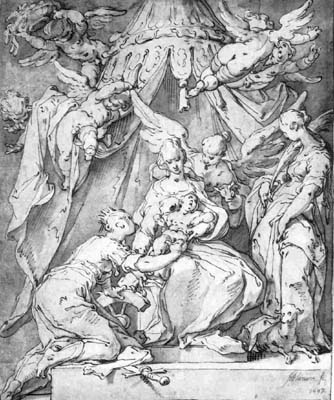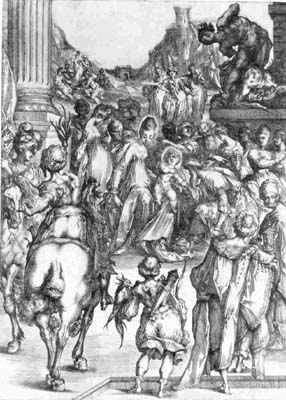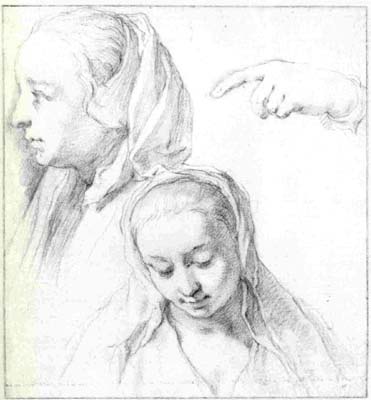
Bulletin 7 (IV:1), 1966
Home
Français
Introduction
History
Annual Index
Author &
Subject
Credits
Contact



Notes on
Two Drawings by Abraham Bloemaert
by Pamela Osler
Assistant Curator of Prints and Drawings
Résumé en français
Page 1 | 2
The National Gallery has recently acquired a drawing by
Abraham Bloemaert (1564-1651), the Mystic Marriage of St
Catherine (Fig. 3). It is signed and dated A Bloemaert fe
1597,
paper with a watermark which seems to be that of a wreathed crown
surmounting an inscription. The drawing, which was formerly in the
collection of Dr Victor Bloch of London, (1) is handled with an
elegance and dexterity that mark Bloemaert's very personal early
manner and which of itself affirms the authenticity of the signature
and date. The style, which is to be found in many drawings by other
artists of the late sixteenth century, is typical of Late Mannerism
in Netherlandish art, of which Bloemaert was the chief exponent in
Utrecht where he lived for most of his life.
As far as is known Bloemaert never went to Italy but he was no doubt
susceptible, particularly as a young man, to the widespread
influences of Italian Mannerism. He was probably familiar with the
mannerist drawings and engravings of Goltzius and Cornelis Cornelisz.
of Haarlem who popularized the Italianized Flemish style of
Bartolomeus Spranger. Certainly, if he was not aware of the work of
these artists in his earliest years, he must have been while
residing in Amsterdam from 1591 to 1593. There the pre-dominating
influence was that of the Haarlem Academy which Goltzius and
Cornelisz. helped to establish.
Before living in Amsterdam, Bloemaert spent some time in the studio
of Hieronymous Franken when he was in Paris from 1580 until 1583.
There he must have known the work of the School of Fontainebleau, as
certain features of the Ottawa sheet suggest. The figures of the
Virgin, St Catherine and St Agnes exhibit the languid grace and
capricious elongation of form so much in evidence in the work of
Primaticcio and Niccolo dell'Abbate, whose styles derive ultimately
from Parmigianino and the Roman School of Mannerists. The densely
grouped figures, barely contained within the spatial limits of the
drawing, and the arbitrary and decorative use of light are also
typical of Mannerism. At the same time the lively treatment of space
and light foreshadows the Baroque, particularly in the playful putti
swirling above the head of the Virgin.
Although Bloemaert's mannerist style owes a great deal to the
influences of Italy it is also dependent upon northern traditions.
The flickering line and the elegant refinement of the figures in the
Ottawa drawing bring to mind the courtly aesthetic of Late Gothic.
This aristocratic atmosphere in Bloemaert's work was at times
expressive of an inner mysticism often found in northern art. A
mystical feeling is particularly evident in the drawing Christ
and the Adulteress (Fig. 2), signed and dated 1595, now in the
Metropolitan Museum of Art, New York. In the New York sheet, this
ecstatic mood is introduced by the imaginative treatment of
elongated figures and by the strained and nervous poses of the hands
and small heads. It is these characteristics that were further
developed by Jacques Bellange (Fig. 1), whose style is the very
quintessence of Mannerism.
Bloemaert's earlier work from about 1591 to about 1610, of which the
Mystic Marriage of St Catherine is characteristic, was
replaced later by a naturalism and realism more native to the Low
Countries than to Italy as may be seen in another drawing, a Sheet
of Studies (Fig. 4), also in Ottawa. Traces of his later
characteristics are already latent in the earlier drawing, which has
a hint of a more intimate domesticity in the figure of the angel who
leans over the shoulder of the Virgin to peer with interest at the
small, uncomfortable - looking Child in its Mother's lap. The
mannered treatment in this drawing gives way to a more objective
sensitivity in the handling of line in the two studies of a female
head which, in its detailed realism and charming naturalness,
suggests a portrait study.
Karel van Mander, who was a member with Goltzius and Cornelisz. of
the Haarlem Academy, 'describes drawing and painting from life as a
"side road or by way" of the arts'. (2) Bloemaert, like
many Dutch artists at the turn of the century, is seen to follow
sometimes in the path of imagination and sometimes in the path of
realism. Van Mander also tells us, however, that 'Bloemaert never
made portraits from life because he did not want to hinder his
imagination by doing so'. (3) If this remark is true, the studies of
the female head are a deceptive fusion of what is imagined
creatively with what is observed.
In this connection it has been suggested that the ideas of the
Italian Mannerist Federlgo Zuccaro, who spent some time in the
Netherlands, may have influenced Dutch art of the early seventeenth
century. He believed that 'the true artist should create a new,
natural world through the imagination, and that he should make new
representations in the spirit of other masters. He ought to do this
so well that even connoisseurs would be deceived by his creative
imitations'. (4) Regarded in this light, Bloemaert's change in style
as seen in the two Ottawa drawings is no more than a shift in
emphasis, from a highly imaginative and often over-wrought mannerist
'short-hand' to a more homely manner that delights in detailed
observation creatively treated.
Next Page | Notes
1 | 2
Annual Index | Author & Subject | Credits | Contact
This digital collection
was produced under contract to Canada's Digital Collections program,
Industry Canada.
"Digital
Collections Program, Copyright
© National Gallery of
Canada 2001"